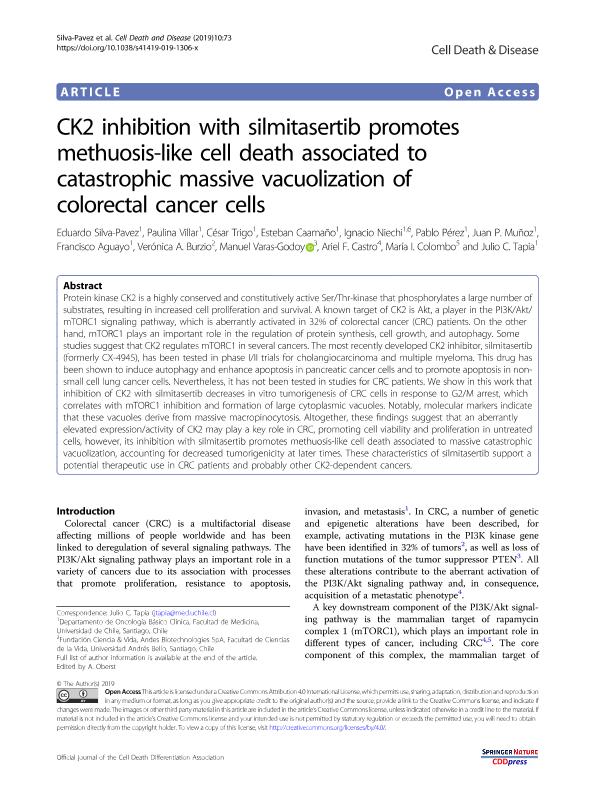Mostrar el registro sencillo del ítem
dc.contributor.author
Silva Pavez, Eduardo
dc.contributor.author
Villar, Paulina
dc.contributor.author
Trigo, César
dc.contributor.author
Caamaño, Esteban
dc.contributor.author
Niechi, Ignacio
dc.contributor.author
Pérez, Pablo
dc.contributor.author
Muñoz, Juan Pablo

dc.contributor.author
Aguayo, Francisco
dc.contributor.author
Burzio, Verónica A.
dc.contributor.author
Varas Godoy, Manuel
dc.contributor.author
Castro, Ariel F.
dc.contributor.author
Colombo, Maria Isabel

dc.contributor.author
Tapia, Julio C.
dc.date.available
2021-01-28T02:58:37Z
dc.date.issued
2019-02
dc.identifier.citation
Silva Pavez, Eduardo; Villar, Paulina; Trigo, César; Caamaño, Esteban; Niechi, Ignacio; et al.; CK2 inhibition with silmitasertib promotes methuosis-like cell death associated to catastrophic massive vacuolization of colorectal cancer cells; Nature Publishing Group; Cell Death and Disease; 10; 2; 2-2019; 1-13
dc.identifier.issn
2041-4889
dc.identifier.uri
http://hdl.handle.net/11336/123990
dc.description.abstract
Protein kinase CK2 is a highly conserved and constitutively active Ser/Thr-kinase that phosphorylates a large number of substrates, resulting in increased cell proliferation and survival. A known target of CK2 is Akt, a player in the PI3K/Akt/mTORC1 signaling pathway, which is aberrantly activated in 32% of colorectal cancer (CRC) patients. On the other hand, mTORC1 plays an important role in the regulation of protein synthesis, cell growth, and autophagy. Some studies suggest that CK2 regulates mTORC1 in several cancers. The most recently developed CK2 inhibitor, silmitasertib (formerly CX-4945), has been tested in phase I/II trials for cholangiocarcinoma and multiple myeloma. This drug has been shown to induce autophagy and enhance apoptosis in pancreatic cancer cells and to promote apoptosis in non-small cell lung cancer cells. Nevertheless, it has not been tested in studies for CRC patients. We show in this work that inhibition of CK2 with silmitasertib decreases in vitro tumorigenesis of CRC cells in response to G2/M arrest, which correlates with mTORC1 inhibition and formation of large cytoplasmic vacuoles. Notably, molecular markers indicate that these vacuoles derive from massive macropinocytosis. Altogether, these findings suggest that an aberrantly elevated expression/activity of CK2 may play a key role in CRC, promoting cell viability and proliferation in untreated cells, however, its inhibition with silmitasertib promotes methuosis-like cell death associated to massive catastrophic vacuolization, accounting for decreased tumorigenicity at later times. These characteristics of silmitasertib support a potential therapeutic use in CRC patients and probably other CK2-dependent cancers.
dc.format
application/pdf
dc.language.iso
eng
dc.publisher
Nature Publishing Group
dc.rights
info:eu-repo/semantics/openAccess
dc.rights.uri
https://creativecommons.org/licenses/by/2.5/ar/
dc.subject
CANCER
dc.subject
CK2
dc.subject
MTORC1
dc.subject
AUTOPHAGY
dc.subject.classification
Bioquímica y Biología Molecular

dc.subject.classification
Medicina Básica

dc.subject.classification
CIENCIAS MÉDICAS Y DE LA SALUD

dc.title
CK2 inhibition with silmitasertib promotes methuosis-like cell death associated to catastrophic massive vacuolization of colorectal cancer cells
dc.type
info:eu-repo/semantics/article
dc.type
info:ar-repo/semantics/artículo
dc.type
info:eu-repo/semantics/publishedVersion
dc.date.updated
2020-11-19T22:02:46Z
dc.journal.volume
10
dc.journal.number
2
dc.journal.pagination
1-13
dc.journal.pais
Reino Unido

dc.description.fil
Fil: Silva Pavez, Eduardo. Universidad de Chile; Chile
dc.description.fil
Fil: Villar, Paulina. Universidad de Chile; Chile
dc.description.fil
Fil: Trigo, César. Universidad de Chile; Chile
dc.description.fil
Fil: Caamaño, Esteban. Universidad de Chile; Chile
dc.description.fil
Fil: Niechi, Ignacio. Universidad de Chile; Chile. Universidad Austral de Chile; Chile
dc.description.fil
Fil: Pérez, Pablo. Universidad de Chile; Chile
dc.description.fil
Fil: Muñoz, Juan Pablo. Universidad de Chile; Chile
dc.description.fil
Fil: Aguayo, Francisco. Universidad de Chile; Chile
dc.description.fil
Fil: Burzio, Verónica A.. Universidad Andrés Bello; Chile
dc.description.fil
Fil: Varas Godoy, Manuel. Universidad de Los Andes; Chile
dc.description.fil
Fil: Castro, Ariel F.. Universidad de Concepción; Chile
dc.description.fil
Fil: Colombo, Maria Isabel. Consejo Nacional de Investigaciones Científicas y Técnicas. Centro Científico Tecnológico Conicet - Mendoza. Instituto de Histología y Embriología de Mendoza Dr. Mario H. Burgos. Universidad Nacional de Cuyo. Facultad de Ciencias Médicas. Instituto de Histología y Embriología de Mendoza Dr. Mario H. Burgos; Argentina
dc.description.fil
Fil: Tapia, Julio C.. Universidad de Chile; Chile
dc.journal.title
Cell Death and Disease
dc.relation.alternativeid
info:eu-repo/semantics/altIdentifier/doi/http://dx.doi.org/10.1038/s41419-019-1306-x
dc.relation.alternativeid
info:eu-repo/semantics/altIdentifier/url/https://www.nature.com/articles/s41419-019-1306-x
Archivos asociados
